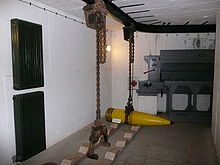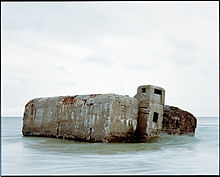Hanstholm Fortress
Coordinates: 57 ° 7 ′ 11 ″ N , 8 ° 37 ′ 11 ″ E
The Hanstholm fortress on the Skagerrak was built during the German occupation of Denmark in World War II and is one of the first fortress structures on the Atlantic Wall . The fortress belonged to the Navy and was occupied by Naval Artillery Division 118 . The actual fortress has been destroyed today, but the area houses a museum that is built on the bunkers of the 2nd battery , the large battery .
history

When the German Wehrmacht conquered France , the Benelux countries of the Netherlands and Belgium as well as Denmark and Norway in 1940 in the course of the Blitzkrieg , they were faced with a serious problem: Great Britain was a sea power. A landing on the beaches of continental Europe could never be ruled out. Therefore, the construction of the Atlantic Wall was planned and started as early as 1940 by the Todt Organization . The first goal of this construction project was the protection of neuralgic points, such as the accesses to the Arctic Ocean and the Baltic Sea , the construction of submarine bunkers in Brest , Lorient , La Rochelle , St. Nazaire and Bordeaux as well as the prevention of landings at suitable points along the English Channel and the North Sea coast. In addition, the resulting bases were to be connected by bunkers and positions and thus create a wall against a landing. However, this ambitious project could never really be completed. One of the first important points of defense was the Hanstholm fortress in Denmark.
The Hanstholm fortress and its sister complex in Kristiansand , the battery "Vara" (named after the fallen general of the pioneers Felix Vara), were built in 1940. Their task was to stop shipping traffic in the Skagerrak and thus block access to the Baltic Sea. The final expansion of the fortress was already completed in 1943. In contrast to the “Vara” battery, the Hanstholm fortress was not just a single battery, but a combination of batteries. The range, especially of the two heavy batteries, was considerable, but not sufficient to bridge the 120 km span of the Skagerrak at this point. The resulting gap was closed by extensive minefields. Both batteries remained in the hands of the Wehrmacht until 1945. When the Allies took over the fortress, 1900 rounds of 38 cm caliber plus the associated propellant charges and several thousand rounds for the smaller caliber were stored there. This illustrates the potential combat strength of Hanstholm Fortress, which it never had to prove.
In general, however, the fortress did not only consist of ship guns. In addition to several radio measuring devices ( radar ), Hanstholm was also equipped with several batteries of light, medium and heavy anti-aircraft guns and was thus part of the German air defense system, especially for northern Germany. Recovered wreckage from Allied bombers are exhibited today and testify to the efficiency of the anti-aircraft systems in Hanstholm. Nevertheless, even the massive anti-aircraft equipment in Hanstholm could not prevent the bombing in Germany. With the use of the radar jamming with "Window" stripes, the batteries in Hanstholm were also paralyzed and could no longer intervene in the bombing war as efficiently as in the years before 1943. It was not possible until the German surrender in early May 1945 to install new radars Install Hanstholm.
While the Danes largely destroyed the fortress in Hanstholm, the Norwegian military used the “Vara” battery for coastal defense until 1952. Both areas have now been converted into museums and are accessible.
The batteries in detail
- I. Battery = four old 17 cm SK L / 40s, completed in 1940, south of Hanstholm
- II. Battery = four 38 cm SK C / 34s , completed in 1942, in Hanstholm itself on a hill
- III.–VI. Battery = four 10.5 cm SKs, completed in 1943, west and south of Hanstholm for air defense
Support troops
- plus more than ten batteries of light, medium and heavy flak of varying strength
- At least one battery of flak headlights (in the course of Operation Gomorrah , the heavy air raids on Hamburg, up to five headlight batteries were temporarily stationed in Hanstholm)
- two radar displays (type Würzburg-Riese and type Freya ) for fire control of the artillery and as a control station for night fighters
The heart of the Hanstholm fortress
The heart of the Hanstholm fortress is undoubtedly the second battery. It consisted of four 38 cm SKC 34 ship guns from the Krupp company . These guns were also used on the battleships Tirpitz and Bismarck . The eight guns of the Hanstholm fortress and the “Vara” battery were supposed to replace the main artillery of the battleships Gneisenau and Scharnhorst , but that never happened. In 1940 the construction of the second battery began. The bunker system of a single gun measured 3000 m². 6560 m³ of reinforced concrete were used for the construction. Each gun could operate independently of the others. This ensured that in the event of a failure, for example the fire control , the battery could continue to operate, as each gun had its own control center . The bunkers had everything that normal combat operations required. In addition to living rooms, sanitary facilities and depots, there is also a fire control system, ammunition bunker and machine rooms. The bunkers were safe from attacks with chemical weapons and were considered bombproof. The manning of a bunker was 62 gun personnel and 50 functional personnel, i.e. machine operators, cooks and others.
The ammunition of the guns was mainly stored in a separate bunker, mainly for safety reasons. Only 65 rounds and the associated propellant charges remained in the actual gun bunker . If required, the ammunition was transported from the ammunition bunker to the gun by means of a field railway, as was the propellant charges. The largest propellant charge that was used weighed 172 kg. Combined with the 800 kg standard grenade, a range of 43,000 m could be achieved. The so-called "Siegfried" bullet was specially developed for these guns. It weighed “only” 500 kg, but with the appropriate propellant charge it reached the considerable range of 55,000 m. In order to load the gun, the grenades and propellant charges were brought from the magazine to the gun turret by means of an elevator. The ramrod used measured 15 m and was operated by twelve men. First the grenade was introduced, then the propellant charge. The smallest propellant charge weighed 92 kg, the largest 172 kg. The powder of the propellant charges was transported in linen bags. These came in steel cartridges. When it was shot down, the burlap sack burned and the steel cartridge was the only “waste” left. It was also possible to combine several propellant charges. As a result, the pipe was worn too much. If the propellant charge exceeded 180 kg of powder, the gun barrel had to be replaced.
The lighter batteries were constructed similarly.
For close defense in the event of any landings, each battery was surrounded by a multitude of bunkers, positions and bases, which should make any direct attack on the fortress by landing troops impossible. These bunkers still exist today.
Film set
The bunkers at Vigsø were the setting for the crime comedy The Olsen Gang goes to Jutland , where they are looking for treasure.
literature
- Bent Bågøe Anthonisen: Hanstholm Fortress. Northern Europe's largest fortification of the Second World War (Danish title: Hanstholm-Fæstningen. Nordeuropas største fæstningsanlæg fra 2. verdenskrig ), Bollerup, Ringkøbing 1985. ISBN 87-981206-1-1 .
- Eckhard Brand: Bunker tours. The tours in the footsteps of our grandfathers. Diary of the visit to the Atlantic Wall in Denmark August 18-22, 2000 , self-published by Eckhard Brand, Halle / Saale 2008. ISBN 978-3-00-025067-5 .
Web links
- Museum Center Hanstholm (Danish)
- Hanstholm Museum in 3D project
- Battery Vara (Norwegian)
- Tours to the positions of the Atlantic Wall in Denmark and France
Individual evidence
- ^ Hanstholmregistreringen (Danish) , accessed April 2, 2019





